by Fionn Adamian // Sept. 11, 2024
The best way to approach the TICK TACK exhibition ‘Streetspace Banger,’ hosted at the Kunsthalle Recklinghausen, is to dive headlong into the effective eclecticism of the curation. The three floors of this massive World War II bunker are crammed to the seams with a diversity of TICK TACK’s collaborators: representing more than 80 artists, the show celebrates the fifth year of the Antwerp institution’s existence (the Kunsthalle Recklinghausen, in turn, will occupy the TICK TACK exhibition space for their upcoming show). In the formal context of a state-backed museum, ‘Streetspace Banger’ feels like a party without parental supervision, worth seeing less for an individual artist than for a glimpse of TICK TACK’s art-in-end-times sensibility.
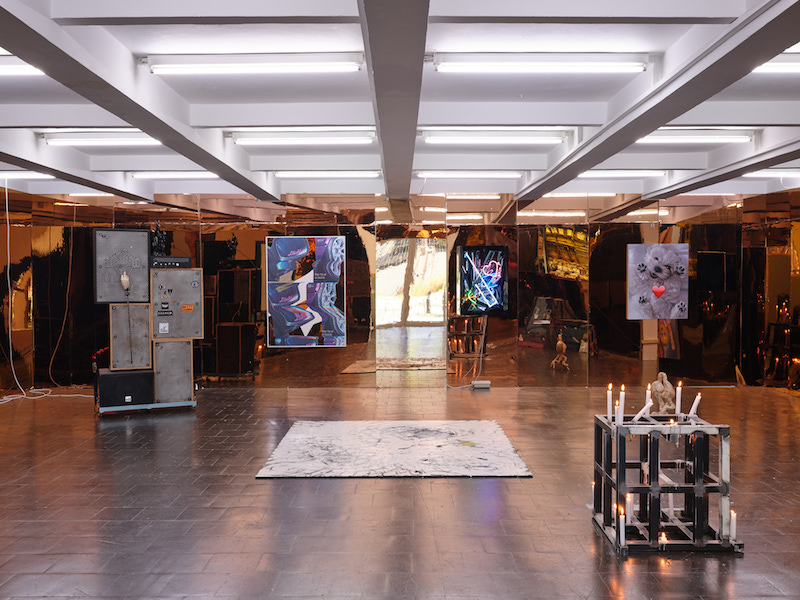
‘Streetspace Banger,’ 2024, exhibition view // Courtesy of TICK TACK
There is a lot to see here, by turns irreverent and maddening, chaotic and precocious. The first work on the ground floor, however, is not to be missed. Allen-Golder Carpenter’s photo collage ‘Untitled (shame wall),’ (2021-2024) depicts an array of CCTV stills that convenience stores have printed out and posted of their alleged shoplifters. Obviously, these stills of surveillance footage are intended as a gotcha moment. No matter whether the expression of the person captured is wary or unconcerned, the message of posting the photograph is the same: don’t make the mistake of thinking that we aren’t watching you. Carpenter’s piece, however, expands this field of surveillance semiotics to include the potential appropriation of these images beyond their use as a petty response to petty theft. On the one hand, the plastic document sleeves encasing the photographs allude to the reconstitution of this footage as evidence in a legal deposition, suturing the inside of the carceral system with the outside of the convenience store. On the other hand, the icon of Carpenter’s instagram account in the left hand corner purports to subsume the artwork into a voyeuristic and densely mediated consumption of spectacle: there at the bottom of the collage is the photo of a girl with a frozen grin, staring down the camera with a pistol in hand.
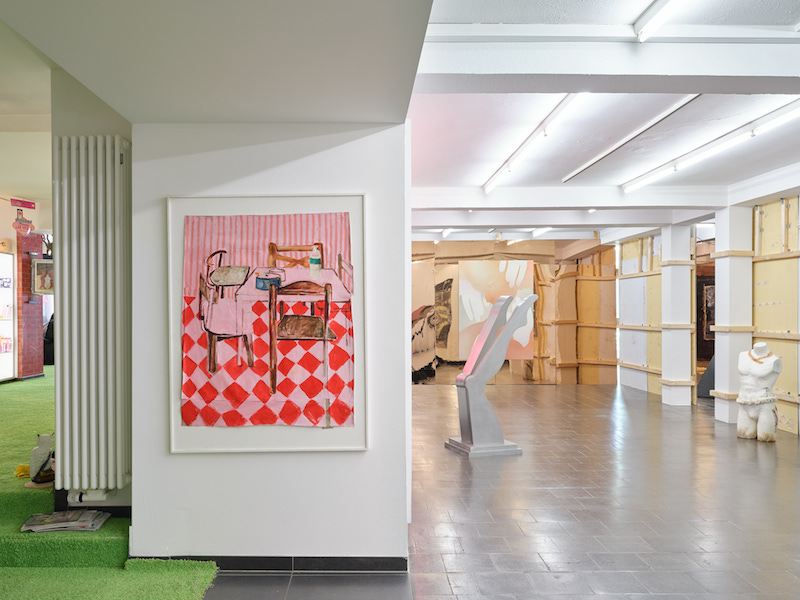
‘Streetspace Banger,’ 2024, exhibition view // Courtesy of TICK TACK
A number of other eye-catching works populate the ground floor, including Narcisse Tordoir’s surreptitious sound system ‘The absent present’ and Liliane Vertessen’s memoiristic photographs that pretend to be erotica. Moving up the flight of stairs, I gave in to the attention-seeking of the Martin Eder painting ‘Death (is a Candy)’ on the main wall of the first floor: two humongous, pearly-eyed kittens floating along the misty surf of a waterfall, with a khaki-clad onlooker tucked neatly in the corner. The painting has the bubblegum aesthetics of hyperpop meets contemplative romanticism meets the tourism industry of Niagara Falls. The monumentality of Eder’s kitsch is exasperating (I know that’s the point of Eder’s painting, to exasperate, but that just exasperates me more). Still, I can admire the unnerving way that the kittens solicit the viewer’s attention in their plush and toylike form, staring into the gallery space as if begging to be taken home and adopted. In the same way that David Lynch’s manicured suburban lawns serve as the setting of his protagonists’ obsession with the taboo, so do Eder’s bright and hallucinatory colors serve as the varnish for an abiding interest in the death drive.
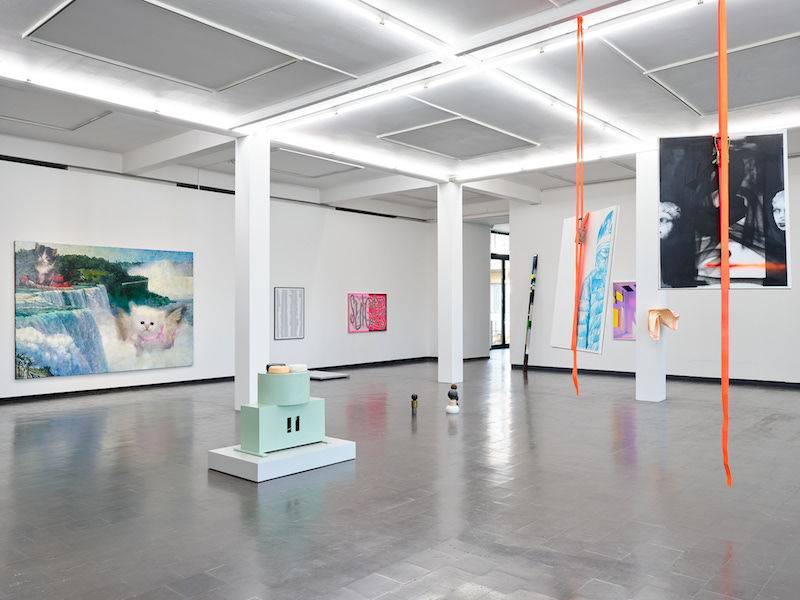
‘Streetspace Banger,’ 2024, exhibition view // Courtesy of TICK TACK
There are a few other artworks on the first floor that share in Eder’s maudlin sense of irony. For instance, Alex McQuilkin’s embroidered aphorism reads, “Banal cannot be rescued by beautiful execution,” which cannot be entirely true judging by some of the other works in the room. Sometimes a beautiful execution rescues that seed of potential from an idea that should, by all means, be completely banal. I can’t explain why a person should be interested in a compendium of German words containing the letters “oral,” but the idea suddenly clicks if you take a look at the execution by Lisa Junghanß, whose hypnotizing poster ‘Oralmoral’ arranges a cross-sectioned index of terms from “edelkoralle” to “professoral” to “oralerotik” in a sprawling concrete poem with sans-serif font.
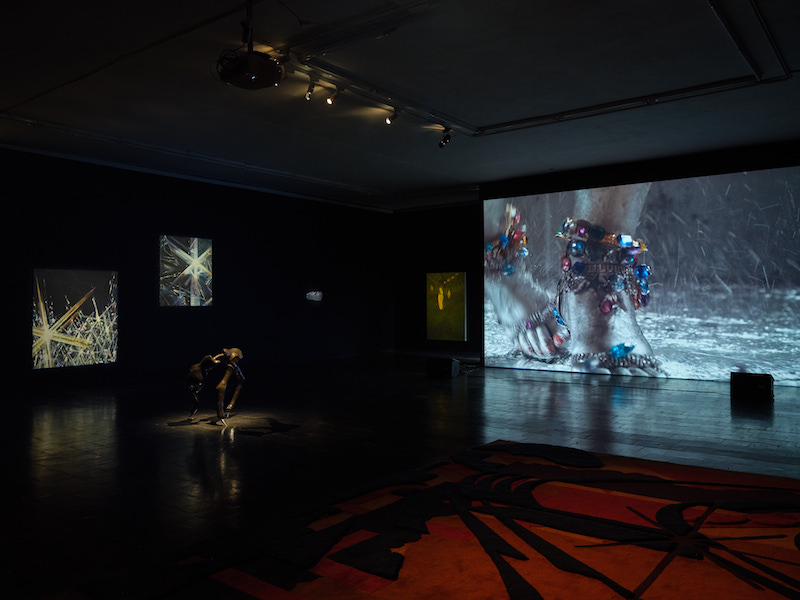
‘Streetspace Banger,’ 2024, exhibition view // Courtesy of TICK TACK
One thing that should be said about the staff of TICK TACK and Kunsthalle Recklinghausen is that they know how to install a pristine exhibition, and whoever managed the technicalities of the lighting on the exhibition’s second floor deserves a raise. The room is set in movie theater darkness for the screening of Marilyn Minter’s ‘Smash,’ a video of a manicured pair of feet, tightly rigged in Jimmy Choos, that shatters a vane of glass serving as the fourth wall between the action and the audience. However, the targeted spotlights give the impression that the remaining artworks stationed around the room are floating out of the darkness toward the viewer, tuning up the eerie aura of a painting like Lenz Geerk’s ‘Vampire’ and the circus-like flexibility of a sculpture like Sally von Rosen’s ‘Miss Universe.’
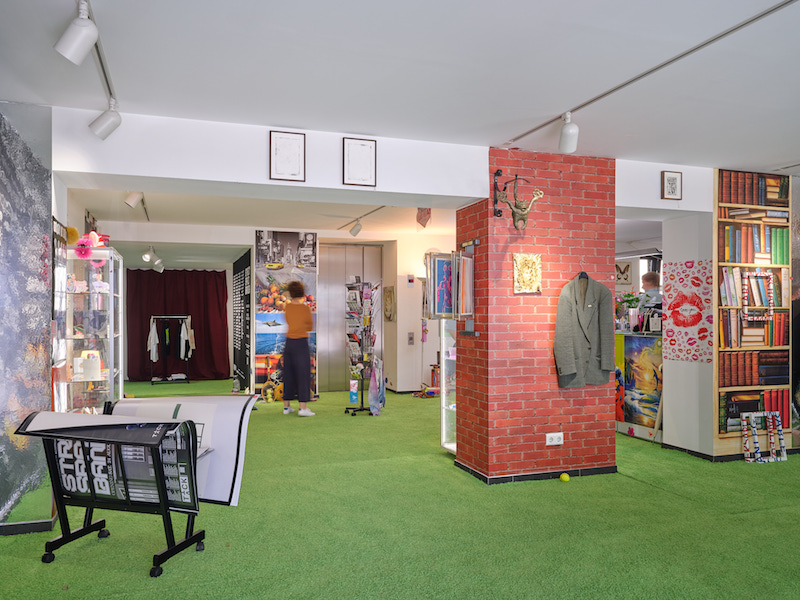
‘Streetspace Banger,’ 2024, exhibition view // Courtesy of TICK TACK
The institution of the state-backed museum tends to behave like a good modernist, in that it affects a performative separation between the exhibited art and the subterranean forces of the market. The exception to this rule, where the geological line between art object and commodity becomes blurred, is the gift shop. The gift shop is supposed to generate loquacious status symbols and to gently remind the visitor of late and neglected relatives that might appreciate a souvenir—a curiously peripheral mix of high culture pretension and shopping mall sentimentality. I say all this because the German artist Christoph Blawert has an altar to maximalist kitsch at the entrance—‘TICK TACK Fancy Museum Shop’—which ought to be taken seriously as an installation in its own right. Taking the place of the Kunsthalle’s normally sparse Bauhaus design, Blawert has constructed a glorified convenience store filled both with twinkling knick knacks and reproduced prints by genuinely talented artists from Antwerp. Like a bodybuilder who’s entered a bulk phase, Blawert assembled the content of the gift shop through a binge of accumulation (in his private life, I was told, he keeps his personal possessions to a strict minimum): there is a bright green, almost turf-like carpet in the entrance, and on the bookshelves, you’ll find tabloid pictures of deceased Belgian royalty and the pop stars of yesteryear. There are multiple customized throw blankets on the couch with the photographs of the teams from TICK TACK and Kunsthalle Recklinghausen. At the end of the exhibition, the curators are also endeared to the visitor in the form of a collectible.
Exhibition Info
Kunsthalle Recklinghausen
Group Show: ‘Streetspace Banger’
Exhibition: Aug. 24-Nov. 10, 2024
kunsthalle-recklinghausen.de
Große-Perdekamp-Straße 25-27, 45657 Recklinghausen, click here for map



















